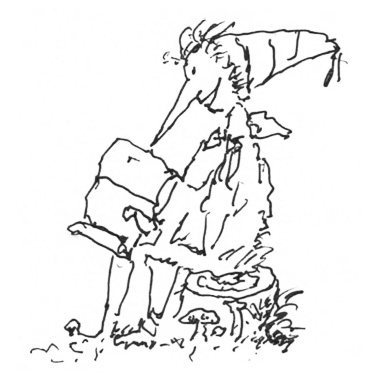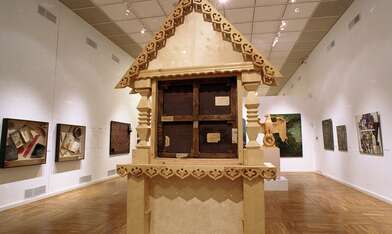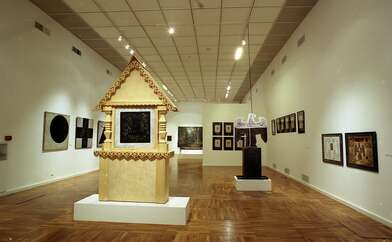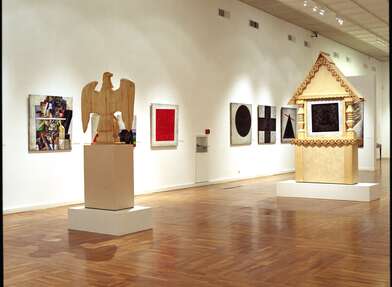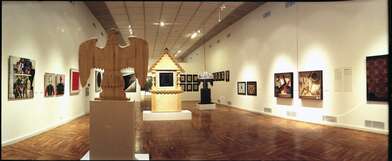Kazimir Malevich’s Black Square, 1915 (fig. 1) and its legacy in the visual arts in Russia has unique significance for avant-garde artists through the Soviet era, particularly after the Thaw (1953-62). For this generation the painting, an irregular rectangle (nearly square) on a white ground, embodies both the myth of creative work of the prerevolutionary period and its real impact on their own. Launched at the “0.10: The Last Futurist Exhibition” in St. Petersburg in December 1915 as a spontaneous and intuitive (though historically self-conscious) act of creative genius, the square was presented by Malevich as the founding element of suprematism. This new utopian visual language, geometric and abstract, aimed to defy traditional concepts of representation and aimed to transform society.
In this essay I will discuss how artists mark their own place in art history by making complex references to preceding traditions, in this case through their returns to the Black Square. Painter Lydia Masterkova and conceptual artist Igor Makarevich are among the many who have drawn this image into their oeuvres; both have actually “repainted” the square, or restaged its reception. My aim is to demonstrate why such returns are compelling creative strategies for artists from later generations and how a work of art such as the Black Square can evoke diverse responses from artists who matured in the same decade and milieu—Moscow in the 1950s and 60s.
In the visual arts, it is often least rewarding, even misleading, to interpret a return to the past as evidence of causation in the present, or in art historical terms, “influence.” This implies that artists are passive recipients of meanings or values that we confer on their sources rather than active agents who shape their culture and history. Typically they are motivated to reclaim an artist, an object, painting, or era. We, as viewers, seek to understand how and to what end. Some artists insist on deliberate and self-conscious historical continuity with the avant-garde past. Others ironically underscore a rupture in that they recognize both the need for and the impossibility of realizing modernism’s utopian message. To interpret the significance of each reworking of the Black Square, our study must move in two directions. As we learn what Masterkova and Makarevich selectively understand in Malevich’s progression toward abstraction we gain a new insight into Malevich’s work, as well as a new perspective on contemporary practices. In the cases discussed below, the artist’s recognition of his or her place in the present is embodied in a dialogue with the past—one that makes such art especially poignant to contemporary viewers. In reconstructing this dialogue and its reception we may come to better understand how art constitutes history instead of merely illustrating it.
Thus, as we recognize the Black Square’s plural meanings in contemporary art we add to (as we may reinforce or alter) the many different values that Malevich himself assigned to the painting. When Malevich repainted that primary form over the course of nearly two decades, he proposed plural philosophical systems through it (four different versions of his Black Square are known to exist, spanning the period 1915 to 1932). They share in Malevich’s conviction that nonobjective art was to generate, in a manner similar to the role of the word/logos in religious thought, a profound attitude of self-awareness in relation to the environment and spiritual world in which we exist. In his various redactions of Suprematism: the World as Nonobjectivity, which he wrote between 1923 and 1926, the artist argued that the material realization of any concept, including through useful objects, is both anticipated and demonstrated by the abstract conceptualization of the art object, though he acknowledged that this relationship would be interpreted variously at different moments in time and in different cultural contexts.¹
A reconsideration of the impact of Malevich’s thought and work on the art of subsequent generations must acknowledge the wider artistic context of the Soviet period. The notion of painting as the preeminent form of creative expression in the visual arts was critical to the perpetuation of the Soviet worldview. The tradition of realism, which enjoyed official status as the style of Soviet art, mystified the connection between painted representation and the object or idea being represented. Social Realist paintings both affirmed the reality they depicted and constituted the mythic narratives through which that reality was perceived. Abstract painting that critically engages such authoritative claims—which is where Malevich’s square has led artists—allowed those who doubted Socialist Realism’s premise (that image equals reality) to question, on that same discursive plane, both the realities of Soviet life, and, equally importantly, its myths.
By invoking the Russian avant-garde, artists of the 1960s like Masterkova (fig. 2) sought the kind of personal accountability through form that produces an authentic art, in contrast to the counterfeit production of Social Realist images that constituted the Soviet norm. But artists differ in the kind of tribute they pay to an avant-garde predecessor. Masterkova doubted Malevich’s singular authority as spokesperson for the Russian avant-garde, but she still found the urge to repaint the Black Square and thereby explore the notions of self-transformation that had always been associated with it. Masterkova approached abstract painting as a revelatory experience, as a “conversion” similar to Malevich’s own, following, in her case, an encounter with American and European abstract expressionist painting that she had seen at the Sixth Festival of Youth exhibition held at Sokolniki Park in Moscow in 1957.² Although Masterkova does not admit to an attraction to suprematism, she admires the objectless (bezpredmetnyi) art that followed, particularly the work of Liubov Popova and Mikhail Matiushin. When she saw examples of their work in George Costakis Moscow apartment in the 1960s, the event recalled the impact of her earlier encounter with abstract painting. As recently as 2002 she stated that for these early twentieth-century abstractionists “painting is like breathing.” Her observation suggests that the organic character of their painting reinforced the structural and expressive concerns of her own abstract language.³
Masterkova’s Black Square (1967) is of this moment; she transforms Malevich’s austere yet irregular geometry into a haunting image of her inner life. She has characteristically layered the form with delicate tracings of ancient lace, fragments of which are embedded into the pigment. Their authenticity as materials overlaying and interacting with her own handwork, suggests the parallel authority of her individual voice, facing her present culture by turning inward, away from the insistent social demands of Soviet life. Fragments of antique textiles that were cut from Orthodox liturgical garments and various other cloths pervade her abstractions of the 1960s and early 1970s. They evoke her fascination with eras known for their rigorous professionalism and depth of culture, evidenced by traditions of individual handcraft (such as embroidery and lacework), that the preceded the hollow rhetorical one in which she found herself. A return in this sense suggests a bypassing or overcoming of one history with a different one, imagined or reconstituted, in which she may choose to participate as a creative individual. Yet through their detail and material excess (compared to Malevich’s), they also expose the perils of committing oneself to self-transformation in the more cynical postmodernist present. In restaging the personal revelatory reception of abstract painting she has created art that has been viewed by some as exotic and marginal in the contexts of both the globalized Western and post-Soviet art worlds. She tends to view herself as an outsider whether as a nonconformist in Moscow or as an independent painter in Europe. A more complete appraisal of her dialogue with the historical avant-garde (beyond the scope of this essay) illuminates the complex appreciation of abstract painting in her era—and enables us to press beyond the limits of our own.
A contrast to Masterkova’s adaptation of Malevich’s image is provided by Makarevich’s Green Square of 1989 (fig. 3). This is the second of two squares the artist painted, and like Malevich repainted in a different context. Makarevich recently has suggested that the utopia proposed by Malevich’s square, is realized most fully in his large conceptual installations based on the theme of Buratino, the Russian Pinocchio.⁴ Although several other conceptual narratives form part of Makarevich’s re-presentation of that story, the one most dependent on Malevich’s paintings is Life in the Snow installed in the Russian Museum, St. Petersburg in 1994. In Makarevich’s oeuvre, we find direct links between narrative modes of display and histories of abstraction. In one room the artist included his own renditions of Malevich’s, Braque’s, and Picasso’s paintings that culminate in his (Makarevich’s) three black squares, monochrome paintings displayed on a shelf like the other objects in the room. In each painting, Makarevich projects the principle of abstraction—demonstrated to varying degrees by Malevich’s progression from cubism to suprematism—to a meta-narrative of progressive historical reasoning. The paintings trace the derivation of nonobjective from figurative art, while the insertion of Buratino within them breaks the relentless flow of one move to another. The image of the puppet stands as the artist’s surrogate, too, reminding the viewer of the ambition and futility—but also the poignancy for Russians—of the utopian dreams Malevich’s paintings embody.
These thematic concerns are also realized in Makarevich’s Green Square. Here, Makarevich casts Malevich’s categorical rejection of conventional, mimetic forms of representation as a statement of doubt; the certainty of figure and ground in Malevich’s work is suspended by Makarevich’s monochromatic rendering. But there is a more profound sense in which Makarevich uses the medium to distinguish his project from Malevich’s, and marks it as one of our own era. Makarevich has explained that he used green in this and other paintings as the opposite, rather than complement of red; the color denies red its symbolic role and dominance within the Soviet environment, “freeing” the artist from its assigned values.⁵ This divergence is supported by others: whereas Malevich’s suprematist paintings suppress the artist’s hand or brushwork, Makarevich has exaggerated it. Makarevich’s very legible brushwork becomes a self-expressive imprint registered as gesture. If it is recognizably his, it is also materially of a different order of subjectivity from the modernist one he quotes because he counts on the viewer to recall its suprematist source. Yet he has painted the work in encaustic (a wax based medium), evoking not only a different artist, the American Jasper Johns, but also a different place in time—America of the 1950s. Makarevich refers the viewer to Johns’s most famous works, his Target series (one is green) and Target with Plaster Casts all painted in 1955 and in collage and encaustic paint on canvas. Both are singular if “found” (pre-existing) forms, appropriated to new expressive ends. Thus the square (both Malevich’s and Makarevich’s) thus enters into a different stream of history, of postmodernist gestures and ethical stances.
Neither Masterkova nor Makarevich present their “squares” as an original in the sense proclaimed by Malevich, as his unique invention. Rather, both offer us a surface onto which we might project our own musings as we hold accountable both the artist and her/his stake in the creative gesture. At the same time, they are in no simple sense a deconstruction of modernism’s fetishism of originality. This distinction is underscored by Makarevich who photographed his Green Square himself, positioned in his studio, atop works that invoke such forms as curiosity cabinets, reliquaries, and sarcophagi (fig. 4). His Traveling Gallery of Artists and Permanent Gallery of 1981 (which contain various representations of Makarevich’s generation of artists, including the Portrait of Bulatov at the right edge of Figure 4) abandon his personal style to underscore the historically momentous character of the era of unofficial art: “the idea itself contained a reflexive concern that was very necessary at the time. It was, in its own way, a kind of attempt to create an infrastructure that Russian art so desperately needed.”⁶ A similar personal investment in a moment of great historical change may explain Malevich’s efforts to universalize his project in Vitebsk through the repetitious studio practices of his students who mastered suprematism by creating variations on the square, breaking open the square, and so forth, and later in his charts and their demonstrations. But in repainting Malevich’s Black Square, Makarevich acknowledges the impossibility of a similar index of validation in his particular location and time.
If an engagement with Malevich’s work and statements helps us to appreciate the multiple meanings of late modernist art then clearly the reverse is also true. As artists attempt to demonstrate their return to the primary language that suprematism represented, their glosses also return value to that originary moment. The Black Square may not be significant to the history of Russian art solely in the sense proposed by Boris Groys, as a singular expression of ambition and symbolic, collective authorship, but as an imprecise plurality.⁷ The many suprematisms that arise from the square as repainted by contemporary artists suggest facets of an exponentially expanding crystal, to use an image invoked by Malevich himself. In this way, as a figure poised between past and present, memory and anticipation, the Black Square should not be seen a structure that collapses into solipsism as so many have argued, for it is sustained by constant replenishment in the art of all those who have in various, often contradictory ways, reclaimed it.
Notes
¹ Malevich revised and republished his thoughts on the range of abstract idioms in contemporary painting several times, in various essays entitled “The World as Nonobjectivity” that appeared in European publications such as Praesens (Warsaw, no. 1, 1926) and in the Bauhaus book, Die Gegenstandlose Welt (Munich, 1927). The Russian redactions appear in Kazimir Malevich, Sobrianie sochinenii v piati tomakh, vol. 2, ed. A. C. Shatskikh and G. L. Demosfenova (Moscow: Gileia, 1998), 55-127.
² Vladimir Nemukhin describes her transformation in an interview with Andrei Erofeev, 1996: “Lida was the first, two or three days after our return, to paint an abstraction in gouache. I felt that everything about her had changed—her eyes, her face—she had become a different person.” ”Russkoe iskusstvo 1960-70 godov v vospominaniiakh khudozhnikov i svedeitel’stvakh ochevidtsev: seriia interv’iu,” Voprosy iskusstvoznaniia IX (2/96): 572.
³ Interview with the artist, May 30, 2002.
⁴ The Pinocchio/Buratino legend was famously realized in Aleksei Tolstoy’s novella, Zolotoi kliuchik ili prikliucheniia Buratino (1935).
⁵ Interview with the artist, November 24, 2004.
⁶ Igor Makarevich in Moi Kabakov/My Kabakov, exhibition catalogue, Stella Art Gallery (Moscow, 2004), 56.
⁷ Boris Groys, The Total Art of Stalinism, (Princeton, 1992).
Jane A. Sharp
Department of Art History
Rutgers University
